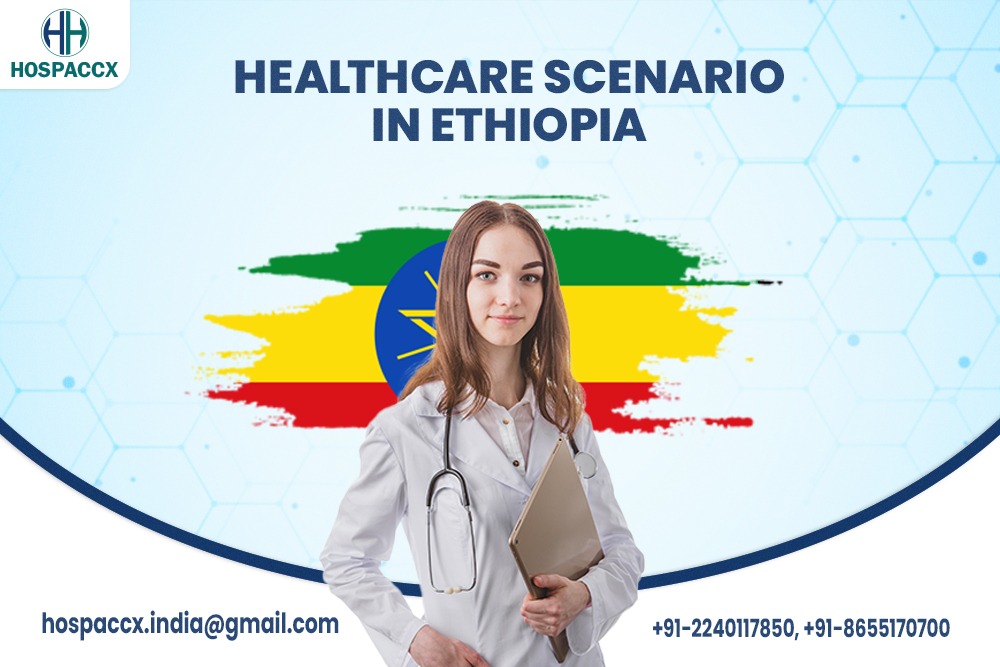In this article, Hospaccx Healthcare Consultancy presents key insights into the healthcare landscape of Ethiopia. We delve into the government’s role in healthcare, the presence of private diagnostic centers, and emerging investment prospects. Whether you’re considering development, restructuring, or investment initiatives within Ethiopia’s healthcare sector, our analysis offers valuable information on existing infrastructure and promising investment avenues.
Introduction
Ethiopia, situated in the Horn of Africa, is a landlocked nation bordered by several countries, including Eritrea, Djibouti, Somalia, Kenya, South Sudan, and Sudan. With a population of approximately 128 million, it ranks as the 13th most populous country globally and the second most populous in Africa. Addis Ababa serves as its capital and largest city. In terms of healthcare, Ethiopia is undergoing a transition to improve accessibility and quality of services. The government is actively pursuing a universal healthcare system, facilitated by a community-based health insurance model. Despite progress, challenges such as demographic shifts and urbanization necessitate more comprehensive healthcare provisions to meet the evolving needs of its diverse population.
Demography
|
Population |
126,527,060 (2023 est) |
|
Population Density |
127 per Km2 (328 people per mi2) (2023 est) |
|
Sex Ratio |
1 (100.860 male per 100 female) (2023 est)
|
|
Ethnicity |
Oromo (34.5%), Amhara (26.9%), Somalie (6.2%), Tigraway (6.1%), Sidama (4%), Guragie (2.5%), Welaita (2.3%), Hadiya (1.7%), Gamo (1.5%), Gedeo (1.3%), Others (11.3%) |

Fig 1. In Ethiopia, the Highest Population is of Ethiopian Orthodocxy 43%, then Islam 34%, Protestants 19%, Traditional beliefs 2%, Catholicism 1% and others 1%
Economy
| Indicator
|
2022 | 2023 | 2024 (Projected)) |
| GDP Growth Rate
(%)
|
5.3 | 5.8 | 6.2 |
| Fiscal Deficit (%)
|
– | 3.1 | 2.5 |
| Current Account Deficit (% of GDP)
|
– | 3.7 | – |
| Inflation Rate (%)
|
– | 28.1 | 20.1 |
| Agricultural contribution to GDP (%)
|
37.5 | – | – |
| Services contribution to GDP (%)
|
36.25 | – | – |
| Industry contribution to GDP (%)
|
21.85 | – | – |
| Main drivers of Growth
|
– | Industry, private consumption, investment |
Some Important Health Statistics
- Total fertility rate – 3.99 live births per woman (2023 est)
- Infant Mortality rate – 29.9 deaths per 1,000 live births (2023 est)
- Maternal Mortality rate – 267 deaths per 100,000 live births (2022 est)
- Urban Population – 23.7% (2023 est)
- Rural Population – 76.3% (2023 est)
- GDP growth rate – 5.8% (2023 est)
Medical Tourism in Ethiopia
| Aspect
|
Details |
| Extent of Medical Tourism
|
Ethiopians spend approximately $500 million annually on medical tourism, seeking advanced treatment abroad. |
| Drivers of Medical Tourism
|
Noncommunicable diseases like cancer, diabetes, and hypertension, coupled with challenges in accessing adequate healthcare locally. |
| Challenges in Local Healthcare
|
Lack of basic equipment and supplies in many healthcare facilities. |
| Shortage of Foreign Currency
|
Hospitals struggle to procure necessary medical imports due to a shortage of foreign currency reserves, particularly the U.S. dollar.
|
| Affected Population | Middle-class and wealthy Ethiopians, who can afford to travel abroad for surgeries, advanced tests, and specialized treatments. |
Major Diseases in Ethiopia
| Diseases | Description |
| HIV/AIDS | Significant concern, focus on prevention and treatment. Over 26,000 cases reported in 2022. |
| Tuberculosis (TB) | Leading cause of death, efforts to scale up prevention. Over 458,000 receive ART in 2022. |
| Cholera | Occur periodically, necessitating public health responses to prevent further spread and morbidity. |
| Measles | Measles outbreaks have been reported, highlighting the importance of vaccination and disease surveillance. |
| Dengue Fever | Cases of dengue fever have been reported, necessitating efforts in surveillance and control measures. |
| Scabies | Scabies outbreaks have occurred, prompting the need for treatment and control measures to minimize spread. |
| Chikungunya | Chikungunya outbreaks have been observed, requiring public health interventions to prevent transmission and morbidity. |
Top 5 Causes of Mortality in Ethiopia
- Tuberculosis: 16.8%
- Malaria: 9.7%
- Intestinal infectious diseases: 9.6%
- Chronic liver disease: 5.6%
- Congestive heart failure: 4.3%
Tuberculosis ranks as the primary cause of death at 16.8%, followed by malaria (9.7%) and intestinal infectious diseases (9.6%). Chronic liver disease contributes 5.6% to mortality. Gender-specific patterns reveal variations in disease prevalence. Targeted interventions are crucial for addressing these health challenges effectively.
Healthcare Scenario in Ethiopia
- Ethiopia faces a complex healthcare landscape characterized by a high burden of communicable diseases such as HIV/AIDS, TB, and malaria, alongside emerging challenges related to non-communicable diseases like cancer and diabetes.
- The government has made significant investments in public health infrastructure and initiatives aimed at improving health outcomes, particularly in rural areas where access to healthcare services remains limited.
- Initiatives to expand health insurance coverage seek to enhance access to healthcare services, but access gaps persist, especially in remote regions.
- Ethiopia is working towards achieving universal health coverage by addressing disparities in healthcare access and quality while adapting to the evolving health needs of its growing population.
Healthcare related Human Resources in Ethiopia (2022)
| 1. General Practitioners | 5,867 |
| 2. Health Officers | 20,223 |
| 3. Lab Technologists | 22,693 |
| 4. Nurses | 58,112 |
| 5. Midwives | 16,883 |
| 6. Pharmacists | 18,844 |
Major Medical Institutions in Ethiopia
PUBLIC
- Paul’s Hospital, Ethiopia – 350 beds
St. Paul Millennium Medical College’s Hospital in Addis Ababa is Ethiopia’s largest medical facility, offering comprehensive healthcare services across 13 specialized departments. Affiliated with the Millennium Medical College, it serves as a vital hub for medical education and training in the country.
- Zewditu Hospital, Addis Ababa – 120 beds
Formerly owned by the Seventh-day Adventist Church, now operated by the Ministry of Health, is a key facility for ART treatment. Serving over 6,000 patients monthly, it offers essential services like palliative care and HIV counseling.
- Gandhi Memorial Hospital, Addis Ababa – 350 beds
Mahatma Gandhi Memorial Hospital, established in 1997, serves districts in Phoenix, Inanda, Amaoti, Mt Edgecombe, and Duffs Road. Offering regional services in various medical fields since 2001.
- Menelik II Referral Hospital, Ethiopia – 800 beds
Established in 1909, is one of Ethiopia’s oldest healthcare centers. Offering specialized services like cardiology and neurology, it serves as a vital tertiary care facility in Addis Ababa, handling 15,000 patients daily.
- Tirunesh Beijing Hospital, Addis Ababa – 100 beds
Opened in March 2012, it serves the Oromia Region and nearby areas, focusing on preventive care and continuous improvement. With ongoing expansion projects, it aims to enhance healthcare access and governance.
- ALERT Hospital, Addis Ababa – 240 beds
Initially dedicated to leprosy care, has grown into a leading medical institution. It Offers diverse services such as conducting research, and providing training. With a nine-decade legacy, ALERT has made significant contributions to addressing health challenges.
PRIVATE
- Gabriel General Hospital, Addis Ababa – 180 beds
Established in 1996, St. Gabriel General Hospital is Ethiopia’s first private healthcare facility. With over 100,000 patients served in 15 years, it operates 24/7, delivering high-quality care by skilled staff and overseas medical experts.
- Teklehaimanot General Hospital, Addis Ababa – 175 beds
Offers trusted multidisciplinary medical services with a patient-centered approach. Recognized for quality and customer care by the Addis Ababa Health Bureau, TGH provides over 70 general, specialty, and subspecialty services.
- Amin General Hospital – 100 beds
Amin General Hospital in Ethiopia recently opened its new facility, expanding its services since its founding in 2012. Offering various specialties like CT Scan and Neurosurgery, it operates 24/7 to serve patients’ needs.
- Adama General Hospital, Addis Ababa – 232 beds
Adama Hospital Medical College (AHMC), founded in 1938, serves over 6 million people from five regions. Upgraded to a medical college in 2003, AHMC is expanding its facilities to meet growing patient numbers.
- Addis Hiwot General Hospital, Addis Ababa – 100 beds
Founded in 2000, is a leading private healthcare facility in Addis Ababa. With over 100 beds and modern amenities, including four operation theatres and intensive care units, it delivers top-quality medical services under the guidance of experienced physicians.
- Hayat Hospital, Addis Ababa – 70 beds
Prioritizes quality patient care and medical education, and commitment to the community. Renowned for specialized healthcare services, the hospital strives to exceed national standards in quality, safety, and patient satisfaction.
- Bethzatha General Hospital stadium, Addis Ababa – 173 beds
Situated in downtown Addis Ababa, has been delivering quality healthcare since 2003. With a skilled team of specialists and dedicated staff, the hospital is committed to serving its patients and improving community health.
- Hamlin Fistula Ethiopia, Addis Ababa – 120 beds
Hamlin Fistula Ethiopia, led by Ethiopian professionals, aims to eradicate obstetric fistula. With over 70,000 women treated, they continue Dr. Catherine Hamlin’s legacy, providing holistic care and empowering women.
Major Diagnostic Centres in Ethiopia
- Pioneer Diagnostic Center, Addis Ababa, Ethiopia
- AFEI Diagnosis Center, Addis Ababa, Ethiopis
- Arsho Medical Center, Ethiopia
- Walif Advanced Diagnostic Center, Addis Ababa, Ethiopia
- Swiss Diagnostics, Ethiopia
- Manna Diagnostic Center, Addis Ababa, Ethiopia
- Addis Hiwot Medium Clinic, Addis Ababa, Ethiopia
- Wudassie No1, Ethiopia
- BMY Diagnostic and Imaging Services, Ethiopia
- Alia Advanced Diagnostic Imaging, Addis Ababa, Ethiopia
Conclusion
Ethiopia’s healthcare landscape reflects a blend of progress and challenges. While the government has made significant investments to improve public health infrastructure and combat infectious diseases, access to quality healthcare remains a concern, especially in rural areas. The presence of private healthcare providers alongside government efforts presents opportunities for enhanced service delivery. With a growing focus on healthcare financing, infrastructure development, and capacity building, Ethiopia is poised to make strides toward achieving universal health coverage and addressing the diverse health needs of its population.
For more details on planning and designing a new hospital in Ethiopia, contact Hospaccx Healthcare Business Consulting Pvt. Ltd. Reach out to us via email at hospaccx.india@gmail.com or visit our website www.hospaccxconsulting.com. We are dedicated to assisting your healthcare endeavors in Ethiopia.
Related Team Members











